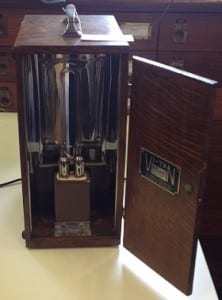Look Again…UV Been Mistaken: A Case of Collection Mis-labelling
By Nick J Booth, on 4 February 2016
This is a guest blog by Felicity Winkley, one of the student engagers who work with UCL Museums. To find out more about the student engagers project please visit their website.
Last term, the UCL Student Engagers used objects from across the UCL collections to curate a six week exhibition at the North Lodge, called Stress: Approaches to the First World War.
The project, as we’ve discussed previously on our own blog, was an interdisciplinary, co-curated effort, approaching the topic of the First World War through four interpretive themes: physical stress, mental stress, cultural or societal stress, and stress on the landscape.
One of the objects we chose to highlight the mental stresses caused by the conflict and, by association, the improvements in the way mental health was approached by the end of the war, was a ‘strobe machine’. As part of the physiology collections, catalogued alongside objects like an auditory acuity tester and a set of keys for tapping multiple-choice responses, it was assumed that this light had similarly been used in psychiatric experiments to test participant responses. From our point of view, it also helped that it looked good.
For several weeks of the exhibition’s run, the object was a successful talking point. The object label – like all those in Stress – had extremely limited object-specific information on it, pointing visitors instead towards the researcher’s motive for choosing the piece. In the case of the strobe machine, this was to discuss the treatment of shell-shock patients throughout the war, as well as early 20th Century attitudes to mental health and masculinity. We cited Siegfried Sassoon’s poem Survivors, written during his time being treated at Craiglockhart military psychiatric hospital (an institution most famously described in Pat Barker’s excellent novel Regeneration), and I had several intense conversations with visitors on the subject.
In November, however, one of our team spotted an identical object in the Wellcome Collection, labelled as a home tanning machine. Until then we had barely given thought to the fact that the maker’s plaque on the inside cover of the ‘strobe machine’ was labelled Vi-Tan, but now it seemed glaringly obvious! The Wellcome Library also contains the accompanying 1936 leaflet, which features in an ongoing three-year research project at the Wellcome on the history of light therapeutics in Britain.

London Leaflet for the “Vi-Tan” ultra-violet home unit from the
Thermal Syndicate Ltd 1936 © Wellcome Library
It goes to show that just as most visitors will happily accept the information the curator has put on the label (unless they categorically know it is incorrect), so the curator themselves can fall in to the trap of taking the catalogue reference at face value. In some instances, we ought to be more prepared to question what is under our noses. Indeed, when I came clean about the tanning machine to a group of visitors I had been engaging with, a few days after our discovery, one told me that she knew it couldn’t have been a strobe, because as the machine contains one large mercury bulb, it could never have flashed rapidly on and off. But would she have challenged me about the label if I hadn’t brought it up?
It is also interesting to think about how the change in classification affected our feelings towards the object; now that it was the “wrong” thing. To me, what had previously felt quite sinister when we thought it was a strobe machine, considered from a military psychiatric perspective, now felt completely different – almost laughable, in the context of the contemporary advertising, with slogans like ‘Plug in to Sunshine’!
In fact, though, knowing the correct use of the object, the physiological benefits of sunlight and light therapies, and treatment of issues such as Seasonal Affective Disorder, our Vi-Tan unit could still have been used in the context of considering stress. Indeed, this is one of the key points of the Student Engager project – to use objects from the UCL Collections that aren’t often brought out and in so doing discover more about them.
Felicity Winkley is a UCL Postgraduate Student Engager at UCL.
 Close
Close



